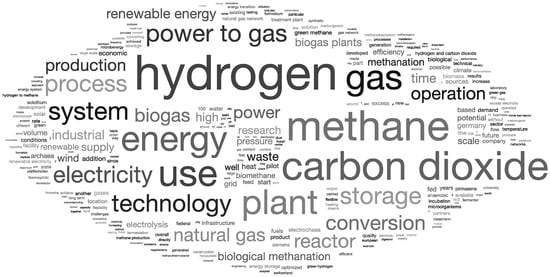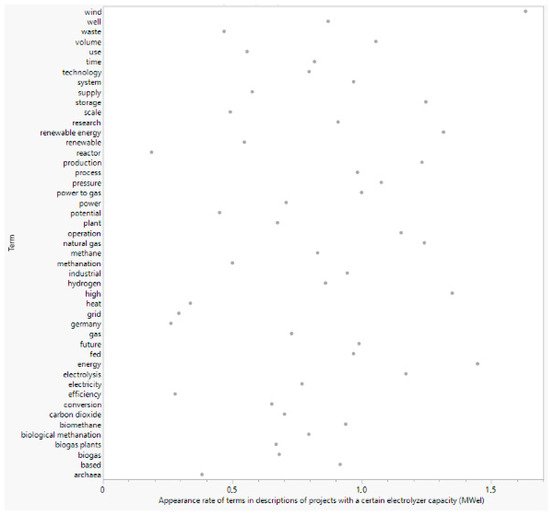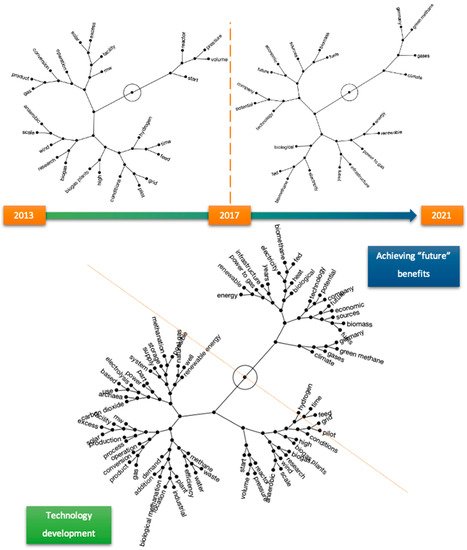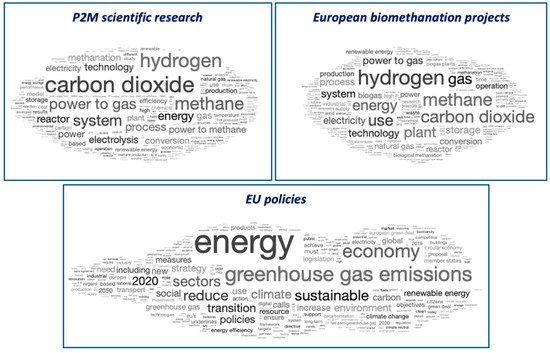In line with the long-term strategy of the European Union to become climate-neutral, the energy storage challenge that is induced by volatile renewable electricity production (e.g., with rapidly growing photovoltaic capacities) must be handled. The power-to-methane technology is promising for long-term, high-capacity energy storage. Currently, there are two different industrial-scale methanation methods: the chemical one (based on the Sabatier reaction) and the biological one (using microorganisms for the conversion). The second method can be used not only to methanize the mixture of pure hydrogen and carbon dioxide but also to methanize the hydrogen and carbon dioxide content of low-quality gases, such as biogas or deponia gas, enriching them to natural gas quality; therefore, the applicability of biomethanation is very wide.
- biomethanation
- power-to-methane
1. Biomethanation Projects and Industrial-Scale Facilities in Europe
-
In contrast to the well-known biogas-based biomethanation projects, the BIOCO2NVERT project aims to implement a biocatalytic P2M facility at one of the largest bioethanol plants of Europe. According to the description of the Innovation Land Lab, installation and commissioning are the next steps of the project [3]. The project started in 2018, and the cooperation partners are Klärgastechnik Deutschland GmbH, MicrobEnergy GmbH, PRG Precision Stirrer Gesellschaft GmbH, and Südzucker AG [4].
-
“Biological biogas upgrading in a trickle-bed reactor” (Tulln/Donau, Austria, 2013);
-
“Biocatalytic methanation” (Cottbus, Germany, 2013);
-
“Forschungsanlage am Technikum des PFI” (Pirmasens, Germany, 2013);
-
“BioPower2Gas-Erweiterung” (Allendorf (Eder), Germany, 2016);
-
“Biologische Methanisierung in Rieselbettreaktoren” (Garching, Germany, 2016);
-
“Einsatz der biologischen Methanisierung […]” (Hohenheim, Germany, 2016);
-
“Biocatalytic methanation of hydrogen and carbon dioxide in a fixed bed bioreactor” (Helsinki, Finland, 2016).
| Projects | Country | City | Start of the Project | Electrolyzer Capacity (MWel) | Status | Source of Status Information |
|---|---|---|---|---|---|---|
| PtG-Emden | Germany | Emden | 2012 | 0.312 | Closed | [2] |
| PtG am Eucolino | Germany | Schwandorf | 2013 | 0.108 | In operation | [11] |
| P2G-Foulum Project | Denmark | Foulum | 2013 | 0.025 | Closed | [12][13] |
| SYMBIO | Denmark | Lyngby | 2014 | - | Closed | [14] |
| W2P2G | Netherlands | Wijster | 2014 | 0.400 | In operation | [15] |
| BioPower2Gas | Germany | Allendorf | 2015 | 0.300 | Closed | [16][17] |
| GICON-Großtechnikum | Germany | Cottbus | 2015 | - | In operation | [18][19] |
| Energiepark Pirmasens-Winzeln | Germany | Pirmasens | 2015 | 1.800 | In operation | [20] |
| Mikrobielle Methanisierung | Germany | Schwandorf | 2015 | 0.275 | - | [21][22] |
| Biogasbooster | Germany | Straubing | 2015 | - | In operation | [23][24] |
| BioCat Project | Denmark | Kopenhagen/Avedore | 2016 | 1.000 | Closed | [25][26] |
| Power to Mobility (MicroPyros GmbH) | Germany | Weilheim-Schongau | 2017 | 0.250 | Under development | [27] |
| STORE&GO | Switzerland | Solothurn/Zuchwil | 2018 | 0.350 | Closed | [28] |
| ORBIT 1st site | Germany | Regensburg | 2018 | - | Closed | [29] |
| BIOCO2NVERT | Germany | Dörentrup | 2018 | - | Under development | [3] |
| HYCAUNAIS | France | Saint-Florentin | 2018 | 1.000 | Under development | [5][6][30] |
| Dietikon Microbenergy | Switzerland | Dietikon | 2019 | 2.500 | Under development | [31] |
| ORBIT 2nd site | Germany | Ibbenbüren | 2020 | 0.001 | In operation | [32] |
| INFINITY 1 | Germany | Pfaffenhofen a. d. Ilm | 2020 | 1.000 | Under development | [33] |
| CarbonATE | Austria and Switzerland | Winterthur | 2020 | - | In operation | [7] |
| Power-to-Gas Hungary plant | Hungary | - | - | 10.000 | In planning | [34] |
2. Key Topics of Future Implementation
2.1. Key Topic 1: The Role of Biomethanation in the Hydrogen Economy

2.2. Key Topic 2: Opening New Ways besides Biogas Plants to Store More Renewable Electricity/Hydrogen

- (a)
-
at the small scale, the focus is on the “efficiency” of the “process”, the “reactor” structure, the microorganisms (“archaea”), and the “biogas” input from “biogas plants”, which contains “carbon dioxide” to “convert” it into “methane”.
- (b)
-
at the large scale, the emphasis is on the “volume” of “wind” or other “renewable energy” and the “production” of “methane”, which can be “fed” into the “natural gas” for “energy” “storage” purposes. (Words in quotation marks refer to the empirical data.)
2.3. Key Topic 3: From Technology Development towards Achieving “Future” Benefits

-
From 2013 to 2016/2017, the emphasis was on “research” and “pilot” implementation; moreover, the fundamental characteristics of the process (e.g., using “excess” “solar” energy, “conversion” into “gas”, connection to the “grid”, and/or “biogas plants”).
-
From 2016/2017 to 2020/2021, broader themes appeared, such as the “future” “potential” of the “technology” realized by a “company”, utilizing “renewable energy” and “electricity”, and producing “green methane”, “biomethane”, or other “fuels” that fit the “infrastructure” to fight “climate” change.
2.4. Key Topic 4: Future Project Planning in Line with Scientific Advancements and Policy Objectives

This entry is adapted from the peer-reviewed paper 10.3390/en14185591
References
- Thema, M.; Bauer, F.; Sterner, M. Power-to-Gas: Electrolysis and methanation status review. Renew. Sustain. Energy Rev. 2019, 112, 775–787.
- Bargiacchi, E. Power-to-Fuel existing plants and pilot projects. In Power to Fuel; Academic Press: Cambridge, MA, USA, 2021; pp. 211–237.
- Innovation Land Lab. Projekte BioCO2nvert. 2021. Available online: https://innovation-landlab.de/projekte/bioco2nvert/ (accessed on 14 July 2021).
- Technical University of Ostwestfalen-Lippe. BioCO2nvert. 2021. Available online: https://www.th-owl.de/ilt-nrw/projekte/bioco2nvert/ (accessed on 14 July 2021).
- Burgundy-Franche-Comté Regional Council. HyCAUNAIS. 2021. Available online: https://www.europe-bfc.eu/beneficiaire/hycaunais/ (accessed on 14 July 2021).
- Ademe. HyCAUNAIS V2. 2019. Available online: https://librairie.ademe.fr/recherche-et-innovation/500-hycaunais-v2.html (accessed on 14 July 2021).
- Zhaw. CarbonATE—Microbiological Methanation. 2021. Available online: https://www.zhaw.ch/en/research/research-database/project-detailview/projektid/3023/ (accessed on 14 July 2021).
- Energy Innovation Austria. CarbonATE. 2021. Available online: https://www.energy-innovation-austria.at/article/carbonate-2/?lang=en (accessed on 14 July 2021).
- Böhm, H.; Zauner, A.; Rosenfeld, D.C.; Tichler, R. Projecting cost development for future large-scale power-to-gas implementations by scaling effects. Appl. Energy 2020, 264, 114780.
- Blanco, H.; Nijs, W.; Ruf, J.; Faaij, A. Potential of Power-to-Methane in the EU energy transition to a low carbon system using cost optimization. Appl. Energy 2018, 232, 323–340.
- German Energy Agency GmbH (dena). Viessmann Power-to-Gas in the Eucolino in Schwandorf. 2021. Available online: https://www.powertogas.info/projektkarte/viessmann-power-to-gas-im-eucolino-in-schwandorf/ (accessed on 19 July 2021).
- Electrochaea. Electrochaea Commissions World’s Largest Power-To-Gas Demonstration Project. 13 August 2013. Available online: https://www.electrochaea.com/electrochaea-commissions-worlds-largest-power-to-gas-demonstration-project-based-on-biological-methanation/ (accessed on 16 July 2021).
- Iskov, H.; Rasmussen, N.B. Global Screening of Projects and Technologies for Power-to-Gas and Bio-SNG; Danish Gas Technology Centre: Hørsholm, Denmark, 2013.
- Panagiotis, T.; Angelidaki, I. Final Project Report-SYMBIO (12-132654); Technical University of Denmark: Lyngby, Denmark, 2020.
- Attero. Our Locations. 2021. Available online: https://www.attero.nl/nl/onze-locaties/wijster/ (accessed on 16 July 2021).
- Heller, T. BioPower2Gas—Power-to-Gas with Biological Methanation. In Proceedings of the Biomass for Swiss Energy Future Conference, Brugg, Switzerland, 7 September 2016.
- IEA Bioenergy. BioPower2Gas in Germany. 2018. Available online: https://www.ieabioenergy.com/wp-content/uploads/2018/02/2-BioPower2Gas_DE_Final.pdf (accessed on 16 July 2021).
- Strategieplattform Power to Gas. Trickle-Bed Reactor for Biological Methanation in the Large-Scale Technical Center of GICON. 2021. Available online: https://www.powertogas.info/projektkarte/rieselbettreaktor-fuer-die-biologische-methanisierung-im-grosstechnikum-der-gicon/ (accessed on 16 July 2021).
- GICON®-Großmann Ingenieur Consult GmbH, Biogastechnikum. 2021. Available online: https://www.gicon.de/leistungen-gicon-consult/forschung/biogastechnikum (accessed on 19 July 2021).
- PFI Germany. Biorefinery at Pirmasens Winzeln Energy Park. 2021. Available online: https://www.pfi-germany.de/en/research/biorefinery-at-pirmasens-winzeln-energy-park/ (accessed on 16 July 2021).
- Energie-Atlas Bayern. Mikrobielle Methanisierung Speicherung Elektrischer Überschussenergie durch Methansierung von Klärgas. 2019. Available online: https://www.energieatlas.bayern.de/thema_sonne/photovoltaik/praxisbeispiele/details,704.html (accessed on 19 July 2021).
- Viebahn, P.; Zelt, O.; Fischedick, M.; Wietschel, M.; Hirzel, S.; Horst, J. Technologien für die Energiewende Technologiebericht—Band 2; Wuppertal Institut für Klima, Umwelt Energie GmbH: Wuppertal, Germany, 2018.
- Strategieplattform Power to Gas. Power to Gas Biogasbooster. 2021. Available online: https://www.powertogas.info/projektkarte/power-to-gas-biogasbooster/ (accessed on 16 July 2021).
- Hannula, I.; Hakkarainen, E. Integrated Bioenergy Hybrids: Flexible Renewable Energy Solutions; IEA Bioenergy: Paris, France, 2017.
- Electrochaea. Energy Storage Leaders Launch Commercial Scale Power-To-Gas Project. 2014. Available online: https://www.electrochaea.com/energy-storage-leaders-launch-commercial-scale-power-to-gas-project-using-highly-innovative-technology/ (accessed on 16 July 2021).
- Lardon, L.; Thorberg, D.; Krosgaard, L. WP3—Biogas Valorization and Efficient Energy Management—D 3.2: Technical and Economic Analysis of Biological Methanation; Powerstep: West Chester, OH, USA, 2018.
- MicroPyros. Reaktorbau. 2021. Available online: https://www.micropyros.de/leistungen-und-service/reaktorbau/ (accessed on 19 July 2021).
- STORE&GO. The STORE&GO Demonstration Site at Solothurn, Switzerland. 2021. Available online: https://www.storeandgo.info/demonstration-sites/switzerland/ (accessed on 16 July 2021).
- FAU. BMWi Projekt ORBIT—Bmwi Optimization of a Trickle-Bed-Bioreactor for Dynamic Microbial Biosynthesis of Methane with Archaea in Power-To-Gas Plants. 2021. Available online: https://www.evt.tf.fau.eu/research/schwerpunkte/2nd-generation-fuels/orbit/#collapse_3 (accessed on 16 July 2021).
- Ademe. HyCAUNAIS V2. 2019. Available online: https://www.ademe.fr/sites/default/files/assets/documents/hycaunais_v2_vf.pdf (accessed on 16 July 2021).
- Viessmann. Grünes Licht für Erste Industrielle Power-to-Gas-Anlage. 2019. Available online: https://www.viessmann.family/de/newsroom/unternehmen/gruenes-licht-fuer-erste-industrielle-power-to-gas-anlage (accessed on 16 July 2021).
- Renewable Carbon, German Government Committed to the Widespread Use of Power-to-Methane Technology. 2020. Available online: https://renewable-carbon.eu/news/german-government-committed-to-the-widespread-use-of-power-to-methane-technology/ (accessed on 16 July 2021).
- Electrochaea. Electrochaea Realisiert Power-to-Gas- Anlage für ein Nachhaltiges Pfaffenhofen. 2017. Available online: http://www.electrochaea.com/wp-content/uploads/2017/11/20171113_PM-Electrochaea_PtoG_fuer_Pfaffenhofen_DE_FIN.pdf (accessed on 16 July 2021).
- Power-to-Gas Hungary Kft. About. 2021. Available online: https://p2g.hu (accessed on 16 July 2021).
- Abe, J.; Popoola, A.; Ajenifuja, E.; Popoola, O. Hydrogen energy, economy and storage: Review and recommendation. Int. J. Hydrogen Energy 2019, 44, 15072–15086.
- Pörzse, G.; Csedő, Z.; Zavarkó, M. Disruption Potential Assessment of the Power-to-Methane Technology. Energies 2021, 14, 2297.
- European Commission. A Clean Planet for All—A European Strategic Long-Term Vision for a Prosperous, Modern, Competitive and Climate Neutral Economy—Communication from the Commission to the European Parliament; European Council: Brussels, Belgium, 2018.
- European Commission. The European Green Deal—Communication from the Commission to the European Parliament; European Council: Brussels, Belgium, 2019.
